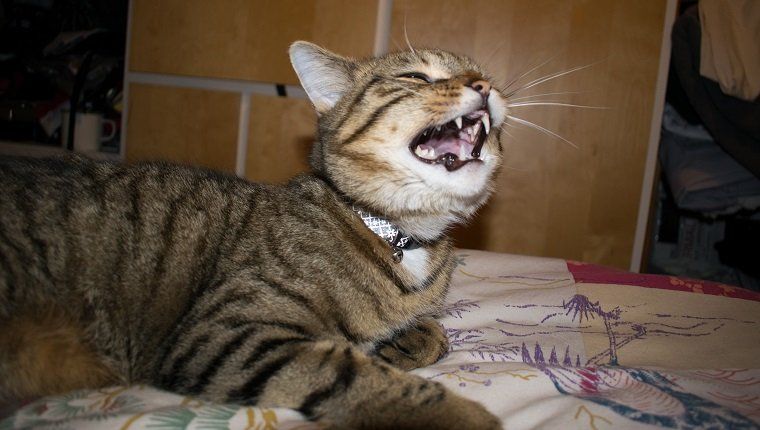Just like us, cats sneeze from time to time. But colds are rather rare in these animals. Find out in this article the reasons why a cat sneezes and if a visit to the veterinarian is advisable.
Table of Contents
Why does my cat sneeze?
Sneezing is an involuntary protective reflex where air is suddenly expelled from the nose and mouth. The purpose of this mechanism is to expel foreign bodies such as dust from the respiratory tract. Sneezing in cats is very common and can come from a wide variety of causes.
When a stimulus activates the glandular cells of the epithelium located in the nasal mucosa, the sneeze reflex is triggered. You should know that the cat has 60 million olfactory cells, while the man has only 20 to 30 million.
So it’s no wonder our little four-legged friends sneeze more often than we do. Sprays, perfumes, dry air or even dust are all reasons that can cause a sneezing attack in cats.
The most serious causes of sneezing
If the Sneezing In Cats is very frequent and accompanied by other symptoms, it is possible that the cause is less trivial. A cat can suffer from sneezing fits due to the following diseases:
- Coryza: this is a whole set of viruses and bacteria that cause what is called the cat cold. Depending on the causative pathogen, the cat exhibits other symptoms such as fever, eye inflammation, or even bronchitis or pneumonia.
- cold: our friends the cats can catch a cold, especially when the temperatures are low. But unlike the common cold in cats, this milder cold usually heals on its own.
- Allergies: Like humans, some cats suffer from allergies. In this case, the immune system overreacts to seemingly harmless environmental stimuli such as dust or pollen. Frequent sneezing is a possible sign of allergy.
- Foreign bodies: it is often the strong blades of grass that make their way into the nasal cavities of cats. Due to the permanent irritation of the nasal mucosa, sneezing is frequent.
- Tumor: Benign and malignant tumors are also a possible cause of sneezing in cats. Often, one also observes a one-sided nasal discharge.
When should you go to the vet?
Punctual sneezing in cats should not worry you. But if your cat is sneezing longer and more often than usual, or has other related symptoms, a visit to theveterinarian is recommended.
The following symptoms combined with very frequent sneezing may be a sign of illness:
- Fever, weakened general health
- Lack of appetite, weight loss
- Discharge from eyes and/or nose
- Breathing difficulties
By speaking with you and using the general clinical examination, the veterinarian will be able to detect the first clues to determine why your cat is sneezing. Depending on the cause suspected by the veterinarian, further examinations will follow. Thus, radiography, endoscopy or ultrasound can be used to detect foreign bodies or tumors.
What prognosis?
In the most common cases, sneezing in cats is a symptom of a mild cold that disappears within a few days. Nevertheless, even a simple cold can be aggravated by bacterial superinfection or other immunodeficiency factors. Moreover, the prevention of a foreign body or a tumor cannot be generalized, because these two causes strongly depend on the type of stimulus (foreign body and tumour) and on the location.
If the cat does not show any pronounced abnormalities in the vital parameters, the veterinarian can carry out the specialized examination , in particular of the respiratory tract. For this purpose, the veterinarian will observe and feel the cat’s nose and mouth ( inspection and palpation ). This clinical examination will allow him to detect potential structural changes or a runny nose, for example.
Then, during auscultation, he will check the trachea and the lungs using a stethoscope. For example, a clicking sound may mean fluid flowing into the airways. On the other hand, a crackle can be a sign of stuck pulmonary bronchioles. In addition to auscultation, the veterinarian can palpate the lung area with the fingers.
In medicine, this is called chest percussion , which analyzes the pitch of the sound produced. These sounds are emitted by different types of tissues. For example, the tone in air-filled lung tissue is high-pitched while the tone in heart muscles is duller. If necessary, the veterinarian may resort to a radiological examination such as X-rays, endoscopy or ultrasound. In this way, he will be able to quickly detect a tumor or a foreign body.
How to prevent sneezing in cats?
Unfortunately, the behavior of the owner of the animal has very little influence on the appearance of tumors as well as on the intrusion of foreign bodies into the cat’s nose. Moreover, these cases are more frequent in outdoor cats that roam outside unsupervised. However, in order to protect cats against respiratory infections such as cat coryza, you can follow these tips:
- If you have several cats: separate the sick cat from the healthy cat
- Regularly clean and disinfect food corners and bowls
- To avoid a cold: dry the coat of the cat when it is wet, abalanced diet and plenty of exercise
- Vaccinate the cat against feline calicivirus, feline herpesvirus, chlamydia and bordetella bronchiseptica












